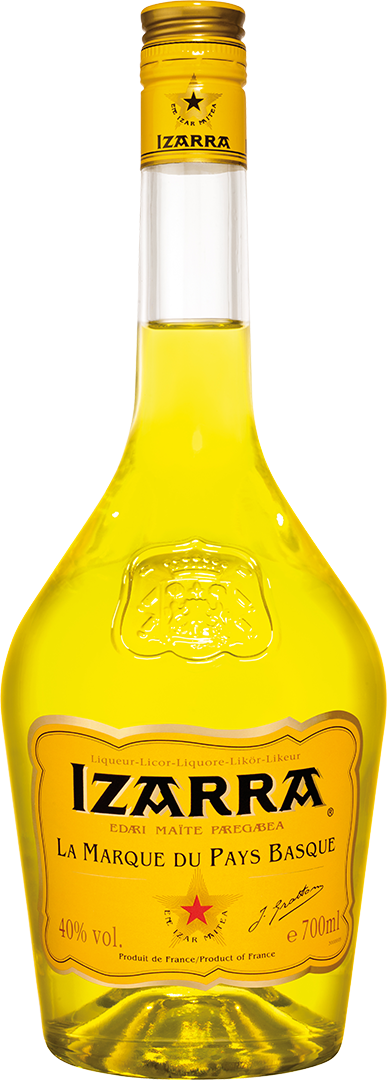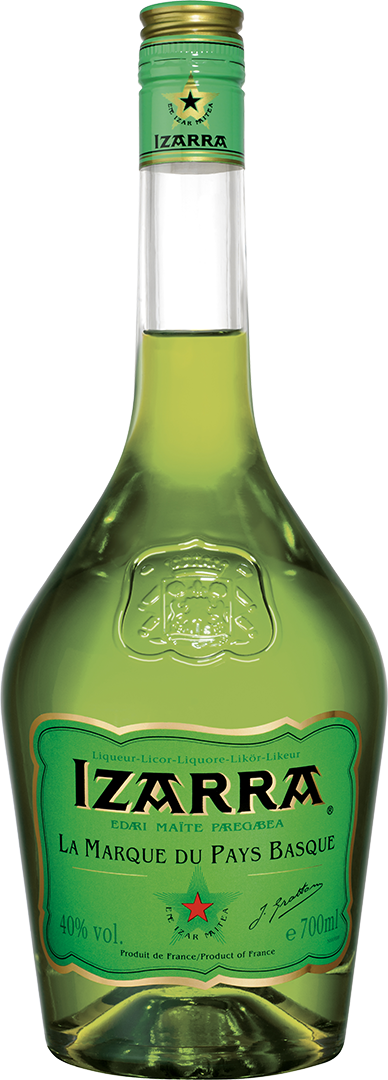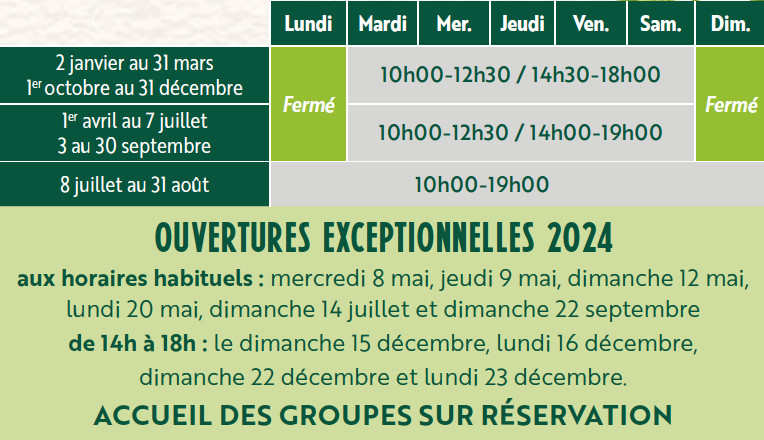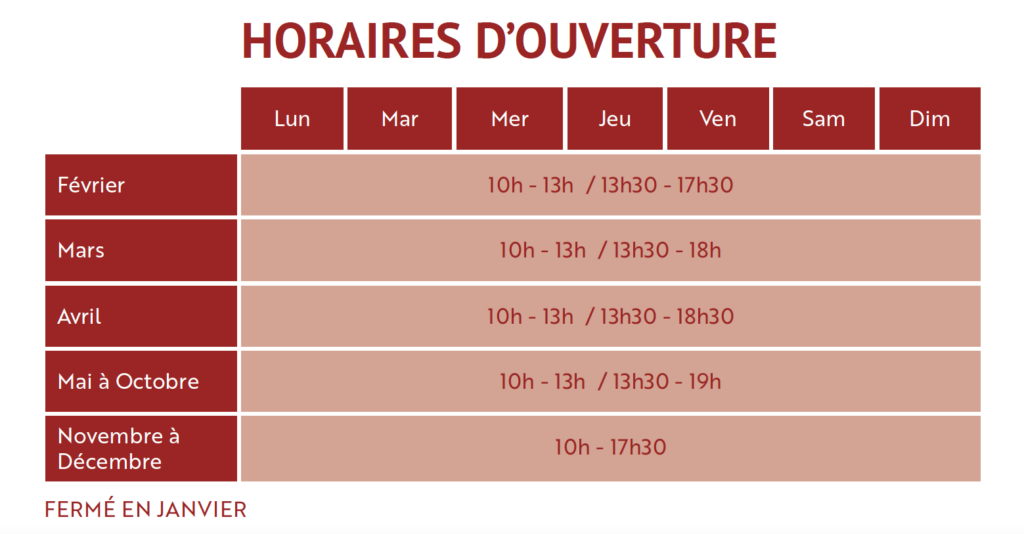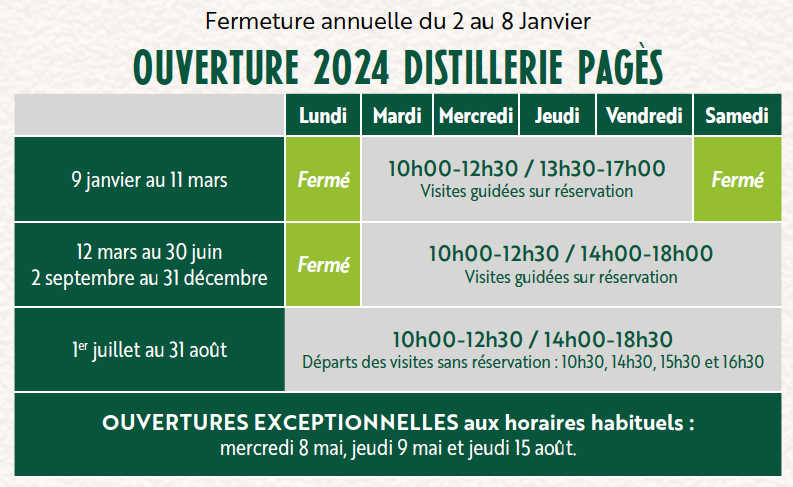IZARRA, since 1906, means star in Basque, is still made according to a recipe made up of more than 10 plants.

Basque Mojito
Ingredients
- 2,5 cl Green Izarra
- 2 cl Cane Syrup VEDRENNE
- 6 to 8 fresh mint leaves
- ½ lime
- Sparkling water
- 10 ice cubes
Method
- Put the mint in the glass without crushing it.
- Add the lime in quarters with the sour, complete with the crushed ice.
- Pour the Izarra and top up with sparkling water.
- Mix.
Production
IZARRA Vert is made from a distillate of various plants and spices, and a double maceration of walnut husks and prunes.
After passing through a copper still, Armagnac Clé des Ducs, the brand’s historical supplier, is added to the distillates.
IZARRA Jaune is the result of the distillation of several plants and spices. Its final blend includes honey, added after the different macerations in alcohol and Armagnac.
In 2023, IZARRA partnered with Jacques SALLES, a local beekeeper for over 30 years, to add acacia honey from the Basque Country to its recipe.
History
Created in 1906, in Hendaye by the gifted botanist and pharmacist Joseph Grattau, it rose in popularity when Grattau moved to Bayonne just before the First World War. It quickly gained a Basque identity (IZARRA means star in Basque), becoming a symbol of the Basque region and establishing itself as a jewel among French liqueurs.
Basque travellers would be sure to take a bottle of IZARRA with them wherever they went, to such an extent that, at its height, IZARRA had production sites in Latin America and Spain. IZARRA was appreciated by all of the Basque country’s illustrious visitors over the course of last century, from Hemingway to Edward VII, Nikita Krushchev and Jean Cocteau.
The Grattau family sold IZARRA to Cointreau (which has since become Rémy Cointreau) in 1981. Still distilled in its region of Nouvelle Aquitaine, thanks to the fashion for mixology, IZARRA became a key ingredient in Basque cocktails.
In 2018, VEDRENNE was granted worldwide distribution of the IZARRA brand.
Izzara, a symbol of the basque country
The distinctive bottle, with its generous curves, has helped Izarra to reach its iconic status. It also bears Bayonne’s motto, “Nunquam Polluta” (Never Sullied).
Over the course of history, famous visitors to the Basque Country have always been given the liqueur as a symbolic gift. After a legendary game of Basque pelota, a triumphant Chiquito de Cambo offered King Edward VII of England his chistera (wicker glove) and a bottle of Izarra.
In the 1950s, Mr Grattau commissioned the most talented poster designer of the time, Paul Colin, to create a poster that became famous, depicting a Basque dancer in midway in front of a bottle of yellow Izarra.
Another poster, designed by Zulla, also contributed to Izarra’s fame. It shows a golden picador whose green horse rears up as he aims his lance at a bottle of yellow Izarra.
The poster advertising was so successful that Izarra commissioned other promotional items. These soon became commonplace in cafés, hotels and restaurants. The objects took their inspiration from Basque dance and sport and proved to be highly popular. Miniature christeras, statuettes of dancers and pelota players, and then of course ashtrays, sets of Mus (a Basque card game), and even Luis Mariano record sleeves appeared in the brand’s colours.
From 1950 to 1970, in honour of its slogan, “le soleil et la neige des Pyrénées” (the sun and snow of the Pyrenees), Izarra organized a competition in which many of France’s top skiers participated.
Since around 2015, Izarra has experienced renewed popularity thanks to a new wave of Basque cocktails, with imaginative recipes such as the Mojito Basque, the Txé, Iza Gorria or the Tik’Izarra.

